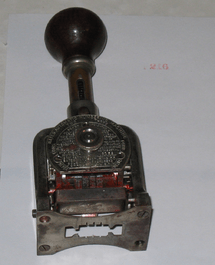Bates numbering

Bates numbering (also known as Bates stamping, Bates branding, Bates coding or Bates labeling) is used in the legal, medical, and business fields to place identifying numbers and/or date/time-marks on images and documents as they are scanned or processed, for example, during the discovery stage of preparations for trial or identifying business receipts. Bates stamping can be used to mark and identify images with copyrights by putting a company name, logo and/or legal copyright on them. This process provides identification, protection, and automatic consecutive numbering of the images.
History
The Bates Automatic Numbering-Machine or Bates stamper is named after the late 19th century inventor Edwin G. Bates of New York City. He obtained several United States patents for the device from 1891 to 1901 and the patents were assigned to the Bates Manufacturing Company.[1][2][3] The earliest patent claimed a "new and useful improvement in Consecutive-Numbering Machines", indicating that Bates was not the originator of the idea. Bates' objective was "generally to increase the effectiveness, simplicity and compactness of machines of this general character". Each time the machine was pressed down onto a sheet of paper, a rotating wheel was moved incrementally. The original machine described by Bates allowed numbering with a four-digit sequence, ranging from 0000 to 9999. For example, page 852 in a document set would be 0852. Courts and law firms quickly adopted this system.
General Binding Corporation (GBC) acquired Bates Manufacturing Company in 1993. As of 2011, Bates numbering machines are sold by Advantus Corporation of Jacksonville, Florida, which acquired the product line from GBC.
Usage
Bates numbering is commonly used as an organizational method to label and identify legal documents. Nearly all American law firms use Bates stamps, though the use of manual hand-stamping is becoming increasingly rare due to the rise in electronic numbering — mostly in Portable Document Format (PDF) files, rather than printed, material. During the discovery phase of litigation, a large number of documents might require the use of unique identifiers for each page of each document for reference and retrieval. Bates numbering, named for the Bates Automatic Numbering-Machine, assigns an arbitrary unique identifier to each page. Such identification may be solely numeric or may contain a combination of letters and numbers (alphanumeric). There is no standard method for numbering documents, nor is there a standard type face used for such numbers.
Manual Bates stampers use a self-inking mechanism with four to seven numbered wheels. Some stampers allow for consecutive, repeat, duplicate and triplicate numbering.
Self-adhesive labels printed with Bates numbers are common today, as is electronic document discovery (EDD) software that can electronically "stamp" documents stored as computer files by superimposing numbers onto them. The Bates Automatic Numbering-Machine is being increasingly replaced by such software, except in cases where electronic versions of the documents are not available or are not practical to produce.
References
- ↑ U.S. Patent 484,389 — Consecutive-Numbering Machine (October 18, 1892)
- ↑ U.S. Patent 676,082 — Automatic Numbering-Machine (June 11, 1901)
- ↑ U.S. Patent 676,084 — Automatic Numbering-Machine (June 11, 1901)
External links
- Company Records Series — Bates Manufacturing Company — The Thomas Edison Papers at Rutgers University. Summary of company history of Bates Manufacturing Co.
- Advantus Corporation, successor corporation of Bates Manufacturing.